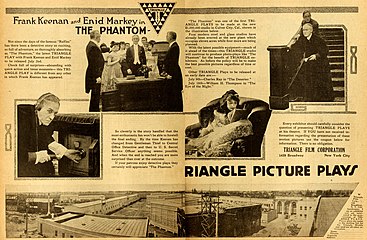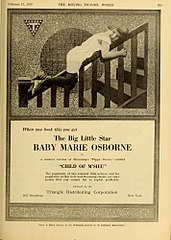
Tillie's Punctured Romance is a 1914 American silent comedy film directed by Mack Sennett and starring Marie Dressler, Mabel Normand, Charlie Chaplin, and the Keystone Cops. The picture is the first feature-length comedy and was the only feature-length comedy made by the Keystone Film Company.

Goldwyn Pictures Corporation was an American motion picture production company that operated from 1916 to 1924 when it was merged with two other production companies to form the major studio, Metro-Goldwyn-Mayer. It was founded on November 19, 1916, by Samuel Goldfish, an executive at Lasky's Feature Play Company, and Broadway producer brothers Edgar and Archibald Selwyn, using an amalgamation of both last names to name the company.
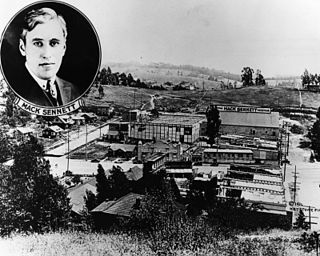
Keystone Studios was an early film studio founded in Edendale, California on July 4, 1912 as the Keystone Pictures Studio by Mack Sennett with backing from actor-writer Adam Kessel (1866–1946) and Charles O. Baumann (1874–1931), owners of the New York Motion Picture Company. The company, referred to at its office as The Keystone Film Company, filmed in and around Glendale and Silver Lake, Los Angeles for several years, and its films were distributed by the Mutual Film Corporation between 1912 and 1915. The Keystone film brand declined rapidly after Sennett went independent in 1917.
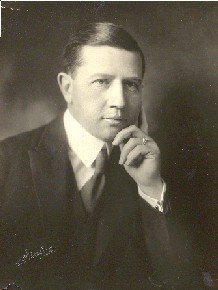
Harry Hazel Culver was a real estate developer and promoter. He was born in Milford, Nebraska, the middle child of five of Jacob H. and Ada L. (Davison) Culver, who lived on a farm. At age 18, he enlisted in the Spanish–American War and served as a corporal and sergeant.

Robert P. Dunn was a comic actor who was one of the original Keystone Cops in Hoffmeyer's Legacy.

Vivian Martin was an American stage and silent film actress.

Dorothy Dalton was an American silent film actress and stage personality who worked her way from a stock company to a movie career. Beginning in 1910, Dalton was a player in stock companies in Chicago; Terre Haute, Indiana; and Holyoke, Massachusetts. She joined the Keith-Albee-Orpheum Corporation vaudeville circuits. By 1914 she was working in Hollywood.
Reliance-Majestic Studios was an early American movie studio in Hollywood, California, originally built around 1914 at 4516 Sunset Boulevard.

Glen W. Cavender was an American film actor. He appeared in more than 250 films between 1914 and 1949.
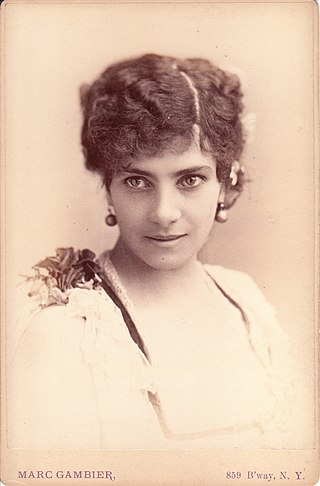
Mary Jane Lee was an American actress of the stage and screen.
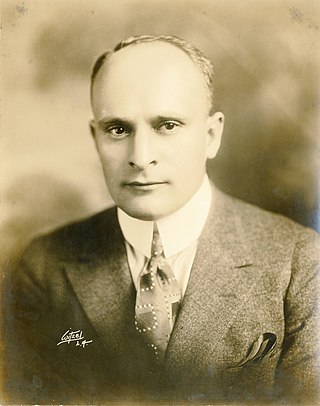
Charles Gardner Sullivan was an American screenwriter and film producer. He was a prolific writer with more than 350 films among his credits. In 1924, the magazine Story World selected him on a list of the ten individuals who had contributed the most to the advancement of the motion picture industry from its inception forward. Four of Sullivan's films, The Italian (1915), Civilization (1916), Hell's Hinges (1916), and All Quiet on the Western Front (1930), have been listed in the National Film Registry.

Thomas Harper Ince was an American silent era filmmaker and media proprietor. Ince was known as the "Father of the Western" and was responsible for making over 800 films.

The L-KO Kompany, or L-KO Komedies, was an American motion picture company founded by Henry Lehrman that produced silent one-, two- and very occasionally three-reel comedy shorts between 1914 and 1919. The initials L-KO stand for "Lehrman KnockOut".
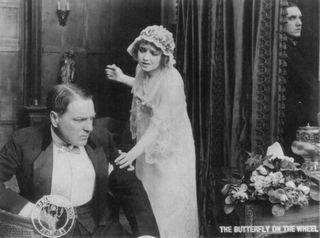
The World Film Company or World Film Corporation was an American film production and distribution company, organized in 1914 in Fort Lee, New Jersey.

Charles O. Baumann was an American film producer, film studio executive, and pioneer in the motion picture industry.

Edward Kline Lincoln was an American silent film actor and director. Lincoln appeared in over 65 silent films and was best known for movies like For the Freedom of the World (1917), The Light in the Dark (1922) and The Man of Courage (1922).

The New York Motion Picture Company was a film production and distribution company from 1909 until 1914. It changed names to New York Picture Corporation in 1912. It released films through several different brand names, including 101 Bison, Kay-Bee, Broncho, Domino, Reliance, and Keystone Studios.
Fine Arts Film Company produced dozens of movies during the silent film era in the United States. It was one of the film production studios in Triangle Film Corporation, each run by one of the parent company's vice-presidents: D. W. Griffith, Thomas H. Ince, and Mack Sennett. Fine Arts was Griffith's studio and was located on Sunset Boulevard. It was often billed as Triangle Fine Arts.

The Dawson Film Find (DFF) was the accidental discovery in 1978 of 372 film titles preserved in 533 reels of silent-era nitrate films in the Klondike Gold Rush town of Dawson City, Yukon, Canada. The reels had been buried under an abandoned hockey rink in 1929 and included lost films of feature movies and newsreels. A construction excavation inadvertently uncovered the forgotten cache of discarded films, which were unintentionally preserved by the permafrost.
Frank Opperman (1861–1922) was an actor in American silent films. In 1916, he was reported to have had a 29-year career on stage and a 7-year film career. Between 1903 and 1907, Opperman appeared three times on Broadway, in Little Lord Fauntleroy, Cashel Byron, and an adaptation of Uncle Tom's Cabin.


